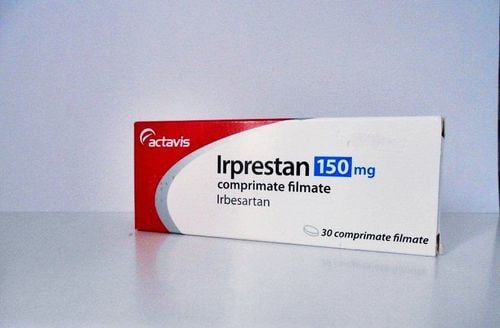This is an automatically translated article.
Ihybes 150mg is used to treat idiopathic arterial hypertension, especially in cases of cough with ACE inhibitors and to reduce the risk of stroke in people with left ventricular hypertrophy. Let's learn about how to use Ihybes 150 mg in the article below.
1. Uses of Ihybes 150
What is Ihybes 150? Ihybes 150 is an antihypertensive drug manufactured by Agimexpharm Pharmaceutical Joint Stock Company, with the main ingredient being irbesartan. Ihybes 150 is indicated for the treatment of:
Idiopathic arterial hypertension, especially for patients taking ACE inhibitors with cough and to reduce the risk of stroke in patients with left ventricular hypertrophy. Type 2 diabetic nephropathy with hypertension. Drug Ihybes 150 is not contraindicated in the following cases:
Hypersensitivity to any component of the drug. Pregnant. Women are breastfeeding.
2. Dosage and how to use Ihybes 150mg
The usual starting and maintaining daily dose is 150 mg once/day, which can be taken with, before or after a meal. A dose of 150 mg once daily provides better 24-hour blood pressure control than a 75 mg dose. Initiate treatment with a low dose of 75 mg once daily for patients on dialysis or over age. For patients whose blood pressure is not controlled at 150 mg once daily, the dose of irbesartan can be increased to 300 mg, or used in combination with other antihypertensive agents. Especially when combined with diuretics such as hydrochlorothiazide has been shown to increase the effect of irbesartan. For hypertensive type 2 diabetic patients, irbesartan 150 mg once daily should be initiated and titrated up to 300 mg once daily as maintenance dose in renal disease. The finding of a renal benefit of irbesartan in hypertensive type 2 diabetic patients was based on studies in which irbesartan was used in combination with other antihypertensive agents as needed to achieve blood pressure levels. desire. Renal Impairment: No dose adjustment is necessary in patients with renal impairment. Hypovolaemia: This should be corrected before irbesartan is administered. Hepatic impairment: No dose adjustment is required in patients with mild to moderate hepatic impairment. Children: The safety of the drug in children has not been established. Dosage should be adjusted after 1-2 months if blood pressure is not controlled. It may take several months of treatment to get good blood pressure under control.
3. Caution when taking Ihybes 150 mg
Hypovolemia: Symptomatic hypotension may occur, especially after the first dose, in patients with hypovolemia such as salt and water loss due to strong diuretics, restrictive diets salt management, diarrhea or vomiting. These conditions should be corrected prior to initiating treatment with Irbesartan. Renal artery stenosis: There is an increased risk of severe hypotension and renal failure when patients with bilateral renal artery stenosis or arterial stenosis of a single functional kidney are treated with drugs that affect the renin-systemic system. angiotensin-aldosterone. Renal failure and kidney transplantation: When using Ihybes 150 in patients with renal failure, it is necessary to regularly check the concentration of potassium, creatinine in the blood. Hyperkalemia: Hyperkalemia may occur when taking the drug in people with poor heart and kidney function. Blood potassium levels should be regularly checked in these patients. Avoid concomitant use of irbesartan with potassium-sparing diuretics. Particular care should be taken when administering Ihybes 150 to patients with mitral or aortic stenosis, hypertrophic obstructive cardiomyopathy. Primary hyperaldosteronism: Irbesartan is not recommended. Pregnancy: This drug is contraindicated in pregnant women. Lactation: Ihybes 150 is contraindicated in women who are breastfeeding. Effects on driving and operating machinery: Caution should be exercised when driving or operating machinery because dizziness and fatigue may occur during treatment with this medicine.
4. Drug interactions of Ihybes 150
Like many other medicines, Ihybes 150 can increase side effects or decrease its effectiveness when combined with the following drugs:
Other antihypertensives: may increase the blood pressure lowering effect of irbesartan; However, Irbesartan can still be combined with beta-blockers, calcium channel blockers, thiazide diuretics. Potassium supplements or potassium-sparing diuretics: Concomitant use may increase serum potassium levels. Lithium: Increased serum lithium concentrations and reversible toxicity have been reported in combination with ACE inhibitors. Careful monitoring of serum lithium levels is recommended if this combination is necessary.
5. Undesirable effects of Ihybes 150 mg
During the use of the drug, the patient may experience some side effects such as:
Common: headache, dizziness, orthostatic hypotension; hypotension in hypovolemic patients (patients taking high-dose diuretics); renal failure and severe hypotension in the presence of bilateral renal artery stenosis. Uncommon: Skin rash, urticaria, angioedema, increased liver enzymes; hyperkalemia, myalgia, arthralgia. To use the drug safely, patients need to absolutely follow the doctor's instructions on dosage and use. When experiencing any symptoms suspected of using Ihybes, it is necessary to notify the doctor for timely treatment measures.
Please dial HOTLINE for more information or register for an appointment HERE. Download MyVinmec app to make appointments faster and to manage your bookings easily.













